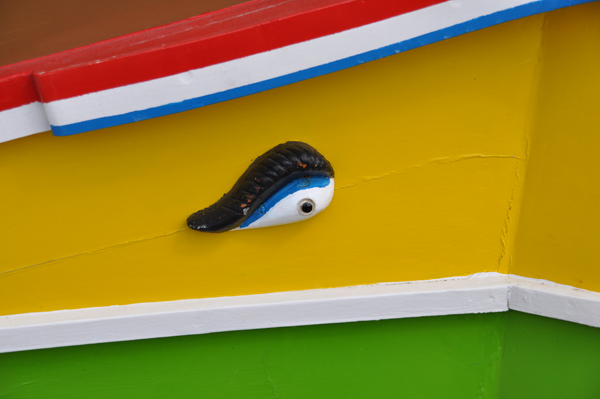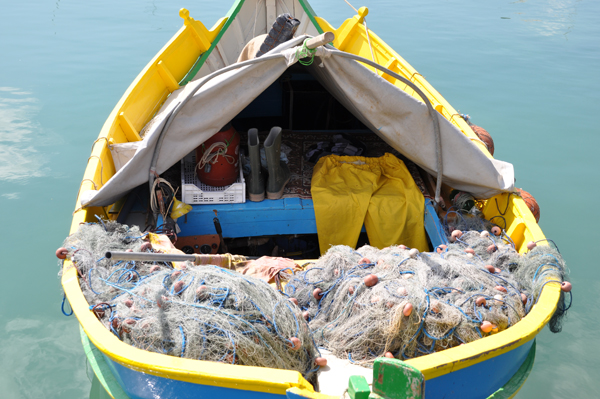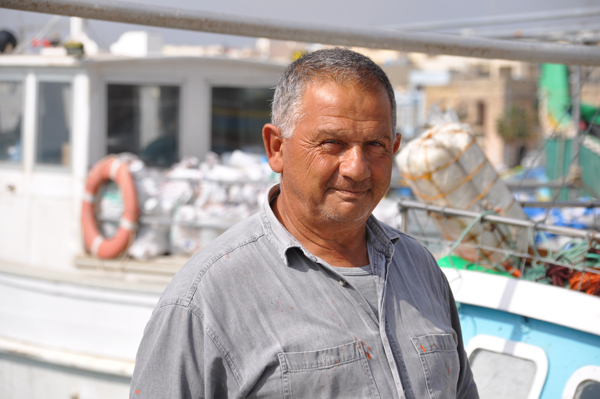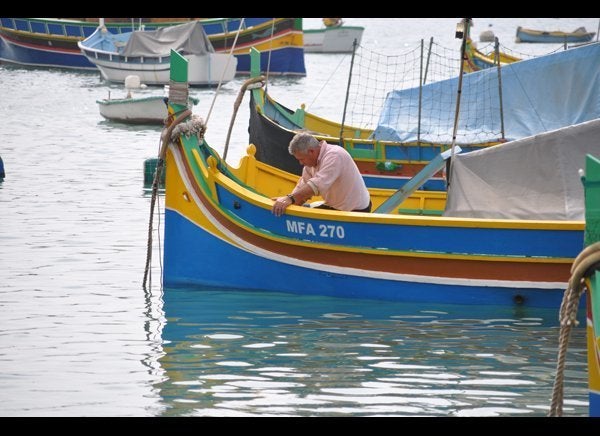
If seen from the seat of an airplane, Malta's outline resembles that of a fish, and Marsaxlokk Bay is at its "mouth." Home to about 70% of the Maltese fishing fleet, the harbor is like a bowl of beautifully-wrapped candy, with scores of vibrantly-painted crafts in hues of yellow, red, blue, green and brown, all nestled side-by-side. The bows of many boats are painted with the symbol of the "eyes of Osiris," a practice believed to have been inherited from another civilization that once called the island home, the Phoenicians, a Mediterranean trading culture dominant from 1550 - 300 B.C.
Decorating the bows evolved from the days when superstitious seafarers created figureheads that originally represented fearsome creatures intended to scare the 'bad spirits' at sea. Later, the figureheads assumed a more altruistic appearance. Traditionally, the bows of Maltese boats boasted a triangular area called the "moustache," which identified its home port, a tradition no longer observed. According to the old custom, when the master was in mourning, this area of the bow was painted black.
I arrived here to find it was market day, and the harbor was abuzz with activity. The shoreline was crammed with stalls selling local handicrafts, merchants vying for the attention of the crowds milling past tables spread with wares. The water was strung with boat upon boat, bow to stern across the crowded bay, fishermen calling to each other as they unloaded their catch. With each step, my eyes were drawn in a dozen different directions, jumping across the intersecting angles, the scene an ever-changing kaleidoscope of primary colors. 
One craft caught my eye and struck a chord with me. I admired the symmetry of the boat's lines, the neatly-organized boots and slicker laid out like clothes before the first day of school. The imagery made me think of destiny-was there in fact a great cosmic plan unfolding and were we all just along for the ride? I had recently made a big change in my life, and while it was one I had chosen, the unfamiliarity of my new course often left me feeling a bit at sea.
I wondered about the boat's owner. Was his life as well-ordered as his gear? Was his existence as simple and predictable as his craft and its contents seemed to intimate? If so, was that a blessing he was thankful for, or a fate he resented? At times knowing what is expected of me can make life easier, and at other times, the hair on the back of my neck can stand up when I think I don't have choices.
I also know a life lived on the water is one at the mercy of the forces of Nature, which is anything but predictable. My response to uncertain or chaotic circumstances is to fiercely attempt to structure what I can. My efforts to rein in life are generally exercises in delusional futility, but ones that can sometimes make me feel better, if only briefly.
Hungry from the sea air and waxing philosophical, I was soon eagerly devouring Stuffat Tal-Qamit, a delicious octopus stew. The harbor is ringed with seafood restaurants, most of them two-storied, family-run enterprises. Business was brisk, with extended families at big tables piled high with platters.
I walked off my hearty lunch with more meandering around the harbor, where I met fisherman Joseph Farrugia. He and his son were unloading the catch from their luzzu (pronounced loots-zoo). They go out every morning just after sunrise to retrieve the nets they put out the prior evening before sunset. Their daily routine is dictated by a startlingly simple fact--in daylight, fish can see the nets.
Like Joseph's boat, almost all those in Marsaxlokk Bay are luzzus. He told me the luzzu is much more suited to a fisherman's work than a fiberglass boat--heavier, more stable, with its shape providing more space for his nets. Joseph uses three different kinds of nets, ranging from 24 - 40 square millimeters, with which he catches bottom fish, such as squid, octopus, and mallet. A good day brings 100 kilos of fish; a bad day can be as little as five kilos.
In the summer months, Joseph may go out as far as ten miles into the sea; in the winter, it's not safe to go out more than a mile. Other than spots off-limits to fisherman, such as sanctuaries and diving sites, he sets his nets all around the island. If he has a favorite watering hole, he wasn't saying.
Joseph said his family has fished for as long as he can remember. His son joined him recently; he was taught by his father and uncles when he was 15, more than 40 years ago.
When asked what he does for fun, Joseph smiled, and replied: "Fish."
I left Joseph's boat, and continued on along the harbor's circumference. Before me, in a luzzu, a fisherman cut a line with his teeth. To his right, a man tugged on one of the piles of blue and green nets he seemed swaddled in. To his left, an old salt took lunch out of a paper bag. Behind him, the dark head of young fisherman popped up from below board, and scanned the horizon.
The string of boats across the harbor called to mind the double helix of a DNA strand, weaving together a millennium of life on Malta's waters, a palpable pattern of time, place and tradition.
My visit to Marsaxlokk reminded me that by daring to cast my net in new waters, and being willing to go where the tide takes me, I was moving closer to the life I believe I was meant to live.
